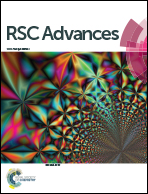Structure and nanomechanics of collagen fibrils in articular cartilage at different stages of osteoarthritis†
Abstract
This study aimed to investigate the variation of structure and nanomechanical properties of human articular cartilage (AC) at different stages of osteoarthritis (OA). The nanoscale morphology, chemical composition, variation of chemical structure, surface adhesion force and elastic modulus were examined. The thickening of collagen fibrils and a decreasing trend of their D-periodic banding patterns were observed along with the progression of OA. The calcium and phosphate concentration in AC showed an increasing trend from Grade 0 to Grade 3. These findings suggest that collagen fibrils have reduced intermolecular interactions, greater molecular disorder and decreased amount and stability of crosslinks in collagen, which may affect the stability of collagen fibrils. The surface adhesion force showed a decreasing trend while the elastic modulus of individual collagen fibrils showed an increasing trend with the advancement of OA, which was confirmed to have a direct functional consequence in the nanostructure of collagen fibrils. This study is helpful for understanding OA pathogenesis and providing an efficient strategy for pre-symptomatic diagnostics of OA.


 Please wait while we load your content...
Please wait while we load your content...